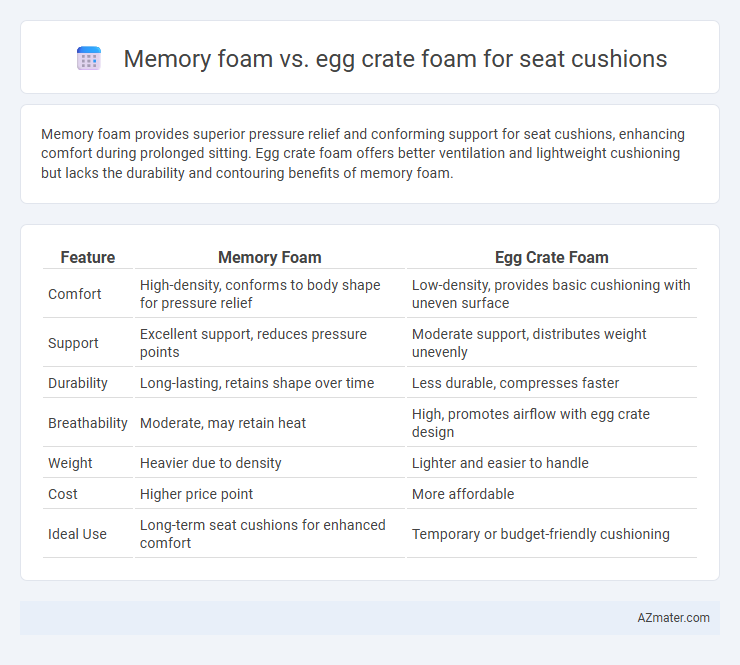Memory foam provides superior pressure relief and conforming support for seat cushions, enhancing comfort during prolonged sitting. Egg crate foam offers better ventilation and lightweight cushioning but lacks the durability and contouring benefits of memory foam.
Table of Comparison
| Feature | Memory Foam | Egg Crate Foam |
|---|---|---|
| Comfort | High-density, conforms to body shape for pressure relief | Low-density, provides basic cushioning with uneven surface |
| Support | Excellent support, reduces pressure points | Moderate support, distributes weight unevenly |
| Durability | Long-lasting, retains shape over time | Less durable, compresses faster |
| Breathability | Moderate, may retain heat | High, promotes airflow with egg crate design |
| Weight | Heavier due to density | Lighter and easier to handle |
| Cost | Higher price point | More affordable |
| Ideal Use | Long-term seat cushions for enhanced comfort | Temporary or budget-friendly cushioning |
Memory Foam vs Egg Crate Foam: An Overview
Memory foam offers superior pressure relief and support by contouring to the body's shape, making it ideal for seat cushions that prioritize comfort and durability. Egg crate foam features a convoluted surface designed to increase airflow and reduce heat buildup but provides less consistent support compared to memory foam. When choosing between them, memory foam cushions typically deliver enhanced ergonomic benefits and longer lifespan for prolonged seating.
Composition and Material Differences
Memory foam seat cushions are made from viscoelastic polyurethane, offering high-density support that conforms to body shape and relieves pressure points, whereas egg crate foam consists of convoluted polyurethane foam designed with peaks and valleys to improve airflow and provide moderate cushioning. Memory foam's cellular structure allows slow response to pressure, enhancing comfort and durability, while egg crate foam's open-cell design focuses on ventilation and lightweight cushioning. These material differences make memory foam ideal for prolonged seating comfort, while egg crate foam suits applications requiring breathability and cost-effectiveness.
Support and Pressure Relief Comparison
Memory foam seat cushions provide superior support by conforming closely to body contours, evenly distributing weight and reducing pressure points for enhanced comfort during prolonged sitting. Egg crate foam offers moderate pressure relief by increasing airflow and cushioning through its convoluted surface but lacks the dense support that memory foam delivers. For optimal support and pressure relief, memory foam is preferred in seat cushions due to its high-density composition and ability to maintain shape under sustained pressure.
Comfort Level: Which Feels Better?
Memory foam provides superior comfort for seat cushions due to its high density and ability to contour to the body, offering excellent pressure relief and support. Egg crate foam, with its convoluted surface, improves airflow and reduces heat buildup but lacks the same level of personalized cushioning and durability as memory foam. For extended sitting periods, memory foam typically feels better by adapting to body shape and maintaining consistent comfort over time.
Durability and Longevity Analysis
Memory foam seat cushions exhibit superior durability due to their high-density polyurethane composition, which maintains shape and support over extended periods, typically lasting 5 to 7 years with regular use. Egg crate foam, made from lower-density polyurethane, tends to compress and degrade faster, offering a lifespan of approximately 1 to 2 years before significant loss of cushioning occurs. Selecting memory foam ensures enhanced longevity and sustained comfort in seat cushions, making it a more reliable option for long-term use.
Breathability and Temperature Regulation
Memory foam seat cushions offer moderate breathability but tend to retain heat due to their dense structure, potentially causing discomfort during extended use. Egg crate foam features an open-cell design with peaks and valleys that promote air circulation, enhancing breathability and improving temperature regulation. For users prioritizing cooling and airflow, egg crate foam cushions provide superior ventilation compared to traditional memory foam options.
Price: Budget Considerations
Memory foam seat cushions typically cost more than egg crate foam due to their superior support and durability. Egg crate foam offers an affordable, budget-friendly option while still providing basic comfort and pressure relief. For cost-conscious buyers seeking a balance between price and cushioning, egg crate foam is often the preferred choice.
Ideal Uses for Memory Foam and Egg Crate Foam Seat Cushions
Memory foam seat cushions excel in providing superior pressure relief and support, making them ideal for prolonged sitting, such as office chairs or wheelchair cushions. Egg crate foam seat cushions offer enhanced ventilation and lightweight comfort, suitable for short-term use or environments prone to heat buildup, like stadium seats or camping chairs. Choosing between memory foam and egg crate foam depends on the need for durability, support, and breathability in seating applications.
Pros and Cons of Each Foam Type
Memory foam seat cushions offer superior pressure relief and conform closely to body contours, reducing discomfort during extended sitting, but they tend to retain heat and can be heavier than other foam types. Egg crate foam provides enhanced air circulation and lightweight comfort, making it a breathable option that helps prevent sweating, though it offers less support and durability compared to memory foam. Choosing between them depends on the need for pressure distribution versus ventilation and portability.
Choosing the Best Seat Cushion for Your Needs
Memory foam seat cushions provide superior pressure relief and contour to body shape, making them ideal for those requiring enhanced comfort and support during extended sitting. Egg crate foam, with its ventilated design, offers improved airflow and moderate cushioning, which suits users prioritizing breathability and lightweight options. Evaluating factors such as durability, support level, and heat retention helps determine whether memory foam or egg crate foam best matches your seating needs.

Infographic: Memory foam vs Egg crate foam for Seat cushion
 azmater.com
azmater.com